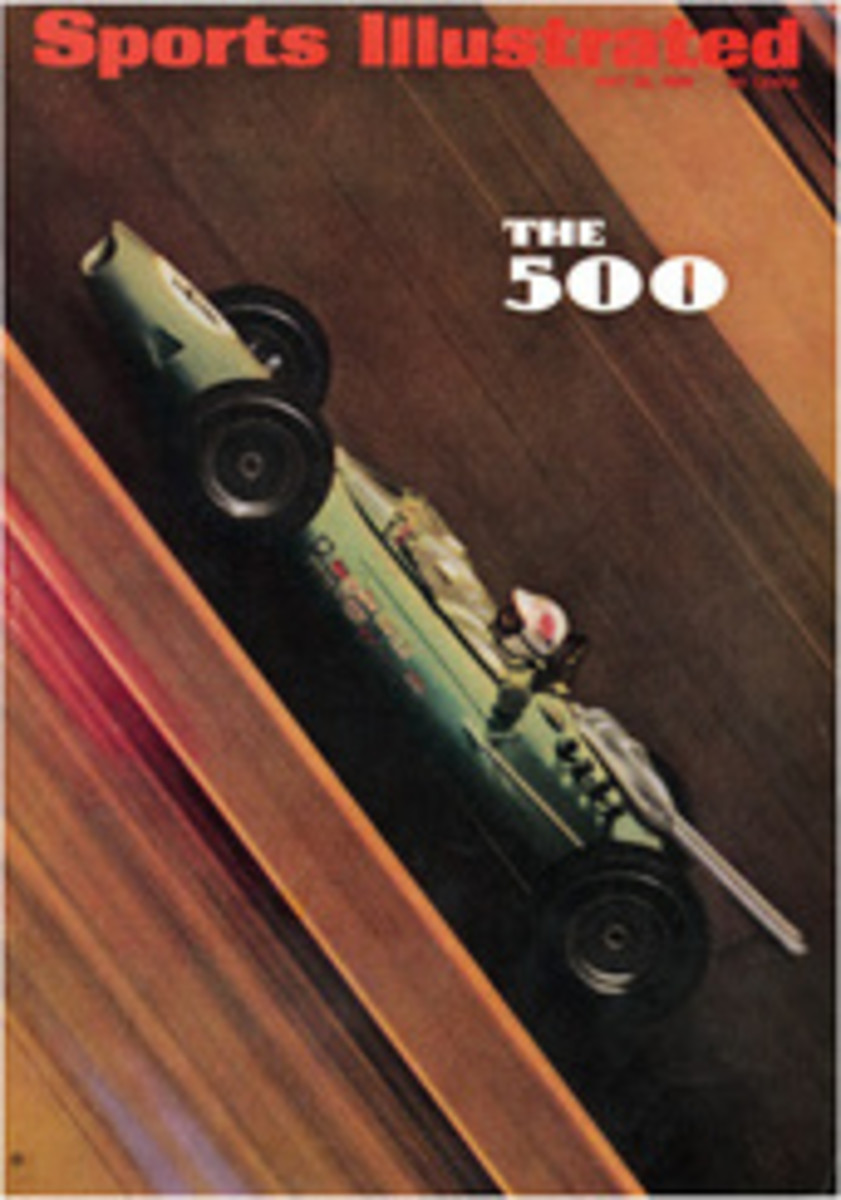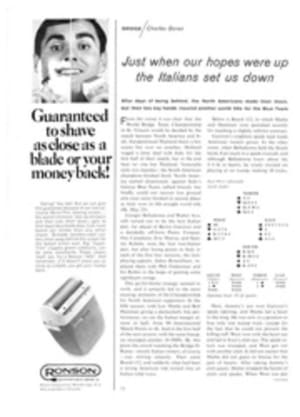
The wreck from down under paces on top
They almost shot him four years ago. The aging gelding had broken his hip on a training track in Western Australia, and if the horse had been insured by the pool-hall operator who owned him, that would have been the end of Cardigan Bay. But they picked up the pieces and put him out to pasture, and after a year, to his owner's surprise, he was ready to race again.
Last Friday night 10-year-old Cardigan Bay was pacing better than any horse in harness. Before a sellout crowd of 36,556 at Yonkers Raceway he defeated the wonder horse of American pacing, brash young Bret Hanover, in a race that was billed, not completely without reason, as the Pace of the Century. Although his driver, Stanley Dancer, rattled the sulky shafts with his whip through the stretch, there was never any doubt that Cardigan Bay would win. He finished the mile race a length in front of Bret Hanover, and from the look of things he would have been the same length ahead at the end of two miles.
Although the crowd—which had sent Bret Hanover off as a 3-to-5 favorite—was appreciative of the fine performance from the old pro, the complete improbability of Cardigan Bay and his background surely escaped most of them. There was, for instance, the piece of bone taken from one of his legs last year and kept among the liniments and bandages back at Stanley Dancer's barn, where Cardigan's groom, Joe Weideman, enjoys showing it off to visitors. There was, of course, his broken hip. "He's a mess," says Dancer. And there was his bizarre history.
Cardigan Bay came from the lush limestone land of New Zealand. The grass in the Southland district seems to make horses strong, and country methods of training and racing give them unusual stamina and durability. A New Zealand horse is not raced much while he is young. Cardigan Bay never started at 2 and made only seven starts at 3 and 4. Bret Hanover, on the other hand, has raced 51 times already and his 4-year-old campaign has just begun.
By American standards there is no money in harness racing down under, but it is a popular pastime in the rural areas. There are numerous small tracks scattered among the farms and there is racing two days a week. Horses are shipped in for a meeting by trailer, raced and sent home that same day to be turned out in their paddocks. The weather is so mild that there are no barns. Nearly all horses are trained and raced right off the grass. "New Zealand horses are rougher than ours," Stanley Dancer says, "and not as well cared for. But they may well be better off."
Cardigan Bay won his first race as a 3-year-old at a meeting in Vincent in central Otago. His purse: $58. The fields are large in these harness races, perhaps as many as 25 starters. Since most of the tracks are only six sulkies wide and three-eighths of a mile around, New Zealand drivers and New Zealand horses know all about traffic jams. "You take off from a standing start," says Dancer. "The first tier of six horses lines up behind a tape stretched across the track, then a second tier of horses puts their noses in your back, and so on. There may be four tiers." Under conditions like this a horse learns to maneuver, and Cardigan Bay has proved to be a master at this in the U.S. The first eighth of a mile of a New Zealand race may take as much as 19 seconds while everyone is jostling about and getting straightened out. The races are anywhere from a mile and five-eighths to two miles long, which can add up to five laps. "You just keep going around until someone rings a bell to signal the last lap," Dancer says.
After a horse wins a number of races, he is handicapped and must start behind the field. When Dancer bought Cardigan Bay in 1964 he was a two-time New Zealand champion and was being penalized 78 yards, which is one of the reasons he was advertised for sale in the U.S. Most horsemen felt the asking price—$120,000—was absurd for an 8-year-old gelding. But Dancer had an idea. He knew several owners who, as he puts it, "had all been in the business awhile and made some money. If the horse was a flop, no one would get hurt badly. I'd been buying expensive yearlings every year and I'd give fifty to sixty thousand dollars for each of them and find out later they couldn't even walk. I thought it might be good to try a different approach, pick up an older horse. Cardigan Bay didn't seem to be too much of a risk."
So Dancer collected $120,000 from seven clients—three housewives, three doctors and Irving Berkemeyer, a hearse-rental man who owns Su Mac Lad, the leading money-winning Standardbred of all time—and set off from New York to see what this Cardigan Bay looked like. What he saw was a mile workout of 2:02 on a three-eighths-mile track, a performance he would not have believed if he had not timed it on his own stopwatch. By now the price was up to $150,000, but the owners eventually settled for $100,000 and an agreement to send Cardigan Bay back to New Zealand when he finishes racing. "They were very attached to him and I think in the end they agreed to the sale only because I promised to ship their old horse back," says Dancer.
Cardigan Bay may be a long time getting home. In the two years he has raced here he has won $517,250 and showed how tough a horse he can be. In 1964 he won nine races against America's best, including a you-win-by-a-nose, then I-win-by-a-nose series with Overtrick that ranks among the sport's most exciting events. After a poor spring in 1965, it was discovered by veterinarians that he had a broken splint bone in his left foreleg. So they simply cut the two-inch bone out, and six weeks later he was winning again. In early December he cracked another bone in the same foreleg, but he finished out the year winning four straight.
Through these same two years, Bret Hanover had overwhelmed all the younger pacers, winning the Triple Crown without effort. He had developed into a big, robust horse with great speed, and by the end of his 3-year-old season had set or equaled 11 world marks. He came into last week's race with a record unparalleled in modern harness racing: 47 wins in 50 races.
A 4-year-old is supposedly at a disadvantage when he meets older horses. Most horses are not fully grown until they are 5. They do not have a full set of teeth until then, and that, horsemen say, is nature's sign of maturity. But Bret Hanover developed early. Maybe he didn't have all his teeth but, as one horseman put it, "He has always looked older. He is an experienced horse and a superhorse. All the rules that apply to horses in general never apply to superhorses."
On his record and his reputation, Bret Hanover had to be the favorite with the bettors in the Yonkers grandstand who were packed in to see the Pace of the Century. But back by the barns where men watch horses closely, Bret was no 3-to-5 favorite. There was hardly a horseman who did not give the advantage to Cardigan Bay. For one thing, he had drawn the No. 3 post position and Bret had No. 5. The other three starters in the field—Firesweep, Sweet Luck and Adios Marches—had been invited to take part in the race by the Yonkers management mainly to insure a normal pace. Otherwise, they were not expected to figure in the race, and their owners were content to settle for third, fourth and fifth money. By drawing a post position inside Bret Hanover, Stanley Dancer was in a position to control the race. If Dancer used this advantage to get in front of Bret Hanover at the start, he could just wait until he saw the young horse pull out to begin his move. A split second later Cardigan Bay could move out from the rail, too, and begin circling the field, staying just in front of Bret, for in those New Zealand races long ago the gelding had learned to accelerate quickly. If Bret Hanover was to beat him, he would have to race wide around him.
Some horsemen also felt Bret Hanover was not yet fit enough to take on a Cardigan Bay, who seemed at his peak, having extended his unbeaten streak to 10. The younger horse had only started twice this season—winning both, to be sure—but he is a horse that needs a great deal of work. His trainer and driver, Frank Ervin, realized the colt might not be tight enough. "I would have liked to have a few more races in him," he said, "but I'm not making excuses ahead of time in case I get beat."
Talking to Ervin before the race, Driver George Sholty said, "You should have waited three weeks and started Bret against Cardigan Bay at Roosevelt Raceway. The stretch there is a good bit longer. Cardigan Bay likes this short stretch. Why, he damn near owns this race track."
"Cardigan Bay will win this one just for the fun of it," said Billy Haughton. "He can move so quickly when Stanley asks him to. Bret takes time to get in gear."
Even Dancer had the feeling. "I think this will be the greatest race, even better than the ones with Overtrick. My horse has never been better." Then he laughed. "I don't mean to sound like Cassius Clay," he added.
What followed was a textbook example of plan and execution, of cause and effect. At the start the two horses inside of Dancer, Sweet Luck and Firesweep, moved out to set the pace. Dancer put Cardigan Bay in third along the rail. On the first turn Ervin made half a move to go past Cardigan Bay, thought better of it when the gelding moved right along with him, and realized he had no choice but to wait. He is still waiting. He pulled Bret over to the rail right behind Cardigan Bay. The pacers went to the half-mile pole Indian file in 59[2/5]. By the three-quarters mark Ervin knew he had to make a move and he also knew exactly what would happen when he did. He pulled out, but quick Cardigan Bay just pulled out in front of him. As the two horses circled the tiring leaders, Ervin had to decide whether to lose lots of ground in the last turn by going three wide or hope he could catch Cardigan Bay in the all-too-short Yonkers stretch. One choice was as hopeless as the other. Bret chose to stay behind Cardigan Bay until the stretch, and that's exactly where he finished.
The crowd booed Bret Hanover afterward—unfairly, for this big young horse should be a champion for years—and losers muttered, "Some Pace of the Century. A race in 2:00." But times of match races are usually slow, and tactics, as often as ability, determine the outcome. This race was no different. Stanley Dancer got control of the situation at the start and kept it to the end. There was nothing Frank Ervin could have done. Except maybe he could have shot Cardigan Bay.
PHOTO
A LENGTH AHEAD OF BRET HANOVER, CARDIGAN WINS THE PACE OF THE CENTURY

